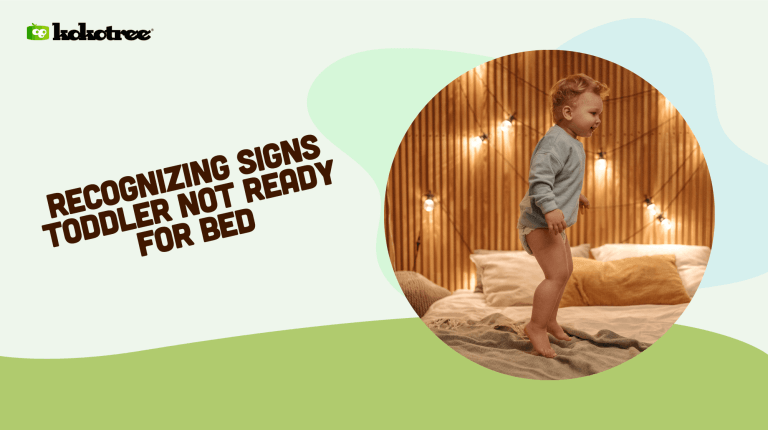

As your little one grows and develops, it’s natural for parents to wonder when their toddler is ready to transition from a crib to a bed. However, this milestone can be challenging and anxious for both parents and children as it symbolizes a major step towards independence.
In this blog post, we will discuss some telltale signs that your toddler might not be quite ready to make that leap just yet, as well as provide evidence-based advice and strategies to help you and your child navigate this new chapter in their life. So, let’s dive in and discover the key indicators to watch for, while also exploring the best ways to prepare your toddler for a smooth transition.
A toddler between 1.5 to 3 years (18 to 36 months) is typically ready for a bed. The exact timing depends on individual growth, mobility, and readiness. Indicators include the child outgrowing the crib or attempting to climb out.
Transitioning a toddler to a bed between 1.5 to 3 years (18 to 36 months) aligns with typical developmental milestones. Children often have a better grasp of rules and safety guidelines by this age. Other indicators for readiness include the child outgrowing the crib or attempting to climb out.
Identifying the signs that your toddler isn’t ready to move from a crib to a bed is essential to ensure a smooth transition. Look for indicators such as resistance to change or the inability to climb out of the crib independently. Additionally, observe whether your child frequently wakes up during the night, displays bedtime anxiety, or refuses to sleep in their crib. By recognizing these signs, you can tailor your approach and employ age-appropriate strategies to help your toddler become more comfortable and prepared for the big switch to a bed.
Toddler development is a complex and ongoing process, with each child progressing at their own unique pace. Parents must understand and respect their child’s individual growth, as this will greatly impact their decision about when to move them from a crib to a bed. Becoming familiar with common sleep patterns and developmental milestones related to sleep is essential to make an informed choice.
The amount of sleep they require will gradually decrease as children grow, but toddlers typically still need substantial rest. On average, your little one should sleep 11-14 hours a day, including naps, to support their development. Sleep patterns and routines can vary greatly, but common bedtime rituals such as reading stories or enjoying a calming bath can help promote healthy sleep habits.
Although there is no exact age or criteria for determining when a child is ready to transition from a crib to a bed, there are several indicators that parents can look for to gauge their child’s readiness.
If your toddler is showing difficulties adjusting to new situations, they may not be emotionally prepared for such a significant change as transitioning to a bed. Be mindful of your child’s temperament, and provide reassurance and support where required.
Typically, one of the main reasons parents consider switching their toddler to a bed is their ability to climb out of the crib independently. If your child has not yet reached this stage, they may not be physically ready for a bed as it can pose safety risks.
If your toddler frequently wakes up during the night, it might indicate that they are not yet sleep trained or experiencing sleep disturbances. Moving them to a bed prematurely can exacerbate these issues, so addressing any underlying sleep problems is essential before making the change.
Toddlers who exhibit anxiety or reluctance at bedtime may struggle with the idea of a new sleep environment. While this emotional hurdle is normal, parents need to empathize with their child and create a comfortable routine that incorporates safety and security elements.
With a better understanding of the signs indicating that your toddler might not be ready to move to a bed, it’s time to explore some practical methods to foster a smooth and successful transition for your child when the time is right.
A predictable and regular sleep schedule can help your toddler feel more secure about their bedtime, easing the transition to a bed. Encourage a routine that includes calming activities such as reading, cuddling, or listening to gentle music before bedtime.
Allowing your toddler to have input in choosing a bed, bedding, or decorations for their sleeping space can help create a sense of ownership and excitement about their new surroundings. This involvement fosters a positive attitude about the change and reduces the potential for resistance.
Your child’s safety should be a top priority during this transition. Assess the sleep environment to remove any hazards or risks, such as loose cords, heavy objects, or sharp corners. Additionally, consider using safety rails or a bed guard to prevent falls and create a secure and reassuring space for your child.
Reassure your toddler that you will be there for them during this significant change, and keep communication lines open. Encourage open dialogue about their feelings or fears, and offer a supportive presence should they struggle with the transition.
Technology has come a long way, providing parents and caregivers with helpful tools to foster a successful transition from a crib to a bed. Educational apps for toddlers can help parents and their children better understand and navigate this process. These apps offer interactive learning experiences tailored to young children, providing a fun and engaging way to teach them about the significance and benefits of moving to a bed.
Many educational apps for toddlers offer interactive storybooks highlighting various sleep-related topics, such as moving to a bed or learning about bedtime routines. Reading these stories together is an entertaining way to initiate conversations about sleep and promote a smooth transition.
Fun and stimulating games or activities within educational apps can help toddlers more readily understand the concept of sleeping in a bed. These activities promote relaxation, sleep hygiene, and consistency, providing an enjoyable platform for learning about their new sleep environment.
The transition from a crib to a bed is a significant milestone in your child’s life and parenting journey. Being patient, providing support, and adapting to your child’s individual needs can go a long way in ensuring success. Understanding the signs indicating that your toddler may not yet be ready for a bed and utilizing evidence-based strategies throughout the process can help your little one embrace this exciting stage with confidence and enthusiasm.
As your child progresses through their journey of growth and development, it is essential to consider other factors that can influence their readiness to move from a crib to a bed. Below, we explore some additional information and tips to keep in mind, which may contribute to your child’s confidence and preparedness during the transition.
It’s worth noting that different cultures and family structures may have unique practices and timetables for transitioning a toddler to a bed. Understanding and respecting these factors can be essential in tailoring your approach to your child’s specific needs and circumstances. Open communication with extended family members and gathering advice from culturally relevant sources can help provide additional insight into making the process a positive and affirming experience.
Sometimes, the issue may not be that your child isn’t ready for a bed, but rather the current sleep environment is causing disruptions. For instance, if your toddler’s crib is located in a shared room with siblings, they may be interrupted throughout the night. Assess your child’s current sleep environment and consider if relocating them to a quieter space or using white noise machines and blackout curtains might help encourage better sleep habits before moving to a bed.
Educating your toddler about the importance of a good bedtime routine helps them understand the need for sleep and nourishes their sense of independence. As children grow, early childhood education should emphasize the importance of self-care, developing responsibility, and nurturing their emotional well-being. Use simple language and visual cues to communicate the steps involved in a routine, such as drinking water, brushing teeth, and putting on pajamas.
Another strategy to consider when transitioning your toddler to a bed is taking a gradual approach. Start by allowing your child to nap in their new bed during the day, while maintaining their crib for nighttime sleep. This step-by-step process familiarizes your toddler with the new sleep environment and may contribute to their confidence and readiness for the eventual transition.
Throughout the transition process, keep track of your toddler’s progress, setbacks, and any emerging patterns. This information can offer valuable insight into your child’s readiness for a bed and help inform future decisions. Remember that every child is different; remaining flexible and adaptable is essential. Don’t be afraid to alter your approach based on your toddler’s unique needs and circumstances.
By considering and incorporating these additional factors into your child’s overall sleep strategy, you can support their development and foster a positive and successful transition from a crib to a bed.
Here are some common questions parents may have regarding their toddler’s sleep transition from a crib to a bed, along with brief answers to help clear up any confusion or concerns. Every child is unique, so these answers may not universally apply to all situations.
No specific age applies to every child, but most toddlers are ready to move to a bed between 18 months and 3 years old. It’s essential to consider your child’s development, maturity, and emotional readiness before deciding.
Use safety rails or a bed guard to prevent falls, and make sure the sleep environment is free of hazards and risks, such as loose cords, heavy objects, or sharp corners. Regularly check for potential hazards and perform ongoing maintenance.
Involve your child in choosing their new bed, bedding, and decorations so they feel a sense of ownership and excitement. Maintain a consistent bedtime routine and provide emotional support and reassurance.
Empathize with your child’s feelings, create reassuring bedtime routines, and offer physical comfort or a favorite toy or blanket. Encourage open dialogue about fears or emotions and provide a secure and comforting environment.
Assess your child’s physical, emotional, and cognitive readiness, looking for signs like climbing out of the crib or expressing interest in sleeping in a bed. Evaluate their existing sleep habits and routines, and provide support where needed.
Consider using a nightlight or teaching your child how to use a flashlight to create a sense of security. Teach basic room navigation skills and encourage independence and problem-solving in the dark.
While some nighttime waking is typical throughout childhood, excessive waking may indicate an underlying sleep issue or anxiety. Address any potential sleep disturbances before transitioning to a bed and consult a pediatrician or sleep specialist if the problem persists.
Educational apps for toddlers can offer interactive storybooks, games, and activities that teach children about the importance of sleep and bedtime routines, creating a fun and engaging way to learn about their new sleep environment.
This choice is mainly based on personal preference and available space. Toddler beds take up less room and may feel more comforting, while twin-size beds provide more space and can accommodate your child as they grow.
The timeline varies based on your child’s individual needs and readiness. Some children may adapt within a few days, while others may take weeks or even months to feel completely comfortable in their new bed.
Establish clear expectations and boundaries regarding staying in bed, and calmly return your child to their bed when they wander. Reinforce the importance of staying in bed through consistent responses and positive reinforcement.
Initiate the transition process by allowing daytime naps in the new bed while still using the crib for nighttime sleep. Gradually progress from naps to nighttime sleeping as your child becomes more confident and comfortable.
Respond calmly and consistently, gently guiding your child back to bed each time. Be patient and persistent to reinforce the importance of staying in bed, and consider adjusting the bedtime routine to address any possible triggers for leaving the bed.




